#capacitance electronic disk
Explore tagged Tumblr posts
Text

This is a capacitance electronic disk, a short-lived video format in which a visual signal was encoded on vinyl. They were stored inside these plastic cartridges to prevent them from being damaged by handling, with the player mechanically removing the disk so the consumer didn't have to touch it.
It was very fragile, it didn't hold much video (most movies being broken up across multiple discs), the player was mechanically complex and therefore prone to problems, and it was proprietary meaning only one company made them.
But there has yet to be a method for sharing images that humanity did not use to share titties.
1 note
·
View note
Text
A Deep Dive into the Technology Behind Absolute Rotary Encoders
This article presents a methodical examination of absolute rotary encoders. It is structured to serve professionals in engineering, automation, and systems design who require detailed technical insight into encoder functionality, configuration, and integration. The following sections explore the classification of rotary encoders, their operational principles, advancements in the field, and future integration scenarios.
Rotary Encoders: Context and Classification
Rotary encoders are instrumental in translating angular motion into electrical signals. These devices form the basis of position sensing in modern electromechanical systems. Their operational relevance spans a broad spectrum of automated processes. Encoders are generally classified into incremental and absolute types. Incremental encoders provide relative motion information and require a reference reset post-power loss. In contrast, absolute encoders deliver precise position values independently of power cycles. This persistent position memory defines their utility in systems where positional continuity is critical.
Absolute encoders function by generating a unique code for each shaft position. Their ability to report a discrete and consistent output for any angular displacement makes them essential for industries that require exact control and fault-tolerant feedback systems.
Structure and Sensing Principles
The construction of an absolute rotary encoder includes a rotating code disk, a sensing module, processing electronics, and an output interface. Each shaft position on the disk is marked with a distinct code, commonly in binary or Gray code. Sensing modalities include optical, magnetic, capacitive, and inductive methods. Optical encoders utilize light transmission or reflection and are known for precision, though they require clean operational environments. Magnetic encoders detect field variations via Hall sensors or magnetoresistive components. Capacitive encoders determine position based on variations in electric field capacitance, while inductive encoders use electromagnetic induction principles.
Each method has defined strengths. Optical systems typically achieve higher resolution, whereas magnetic and capacitive systems offer superior environmental resilience. Inductive encoders, although less common, present an emerging option for robust industrial applications requiring noise immunity and minimal maintenance.
Comparative Technologies: Optical vs. Magnetic
When considering implementation, optical encoders remain the choice for applications that demand fine resolution in controlled environments. They rely on light interruption through slotted disks or reflection from patterned surfaces. However, their sensitivity to contamination may limit their deployment in less-than-ideal conditions.
Magnetic encoders are widely adopted in applications subject to vibration, dust, and oil. Their non-contact sensing makes them suitable for heavy-duty machinery and transport systems. Capacitive and inductive alternatives provide further enhancements in terms of resistance to environmental interference, making them increasingly viable for challenging deployment scenarios.
Rotation Measurement Types
Absolute rotary encoders are available in single-turn and multi-turn variants. Single-turn encoders are limited to measuring the shaft position within one full rotation. Multi-turn models incorporate mechanisms—either mechanical gears or electronic counters—that track full shaft revolutions in addition to angular displacement. The latter is particularly necessary for tasks involving extended motion sequences, such as those found in elevators or automated gantries.
Advanced multi-turn encoders now utilize gearless technologies that store revolution data in non-volatile memory or harvest rotational energy to maintain state across power cycles. These designs reduce mechanical complexity and enhance operational reliability.
Innovations and Performance Enhancements
Recent developments have enabled absolute encoders to incorporate integrated processing capabilities, real-time data filtering, and diagnostic feedback. These functions support features such as thermal compensation, auto-calibration, and error reporting. Wireless connectivity options have also emerged, enabling remote condition monitoring and configuration via industrial IoT frameworks.
Design efforts are increasingly directed at reducing power consumption and improving recyclability. Components are now often chosen for their energy efficiency and compatibility with circular manufacturing practices. Encoder housings and electronics are being developed with modularity in mind to support simplified end-of-life management.
Functional Deployment Scenarios
Absolute encoders find practical application in numerous systems. In robotics, they assist with kinematic positioning and feedback loop integrity. Aerospace systems rely on them for actuator control and status monitoring. In medical contexts, they enable precise alignment in imaging and surgical automation. Manufacturing environments integrate encoders into CNC equipment for tool positioning and quality assurance.
In energy production, encoders are used to control turbine blades or track solar array alignment. Transportation networks utilize them for rail system tracking and autonomous vehicle localization. The consistency and adaptability of absolute encoders allow them to serve effectively in both routine and critical operations.
Criteria for Encoder Selection
Selecting an encoder involves an evaluation of mechanical, electrical, and environmental parameters. Resolution and positional accuracy must align with system requirements. Protection ratings (e.g., IP65, IP67) indicate resilience to ingress. Output interfaces (e.g., SSI, BiSS, EtherCAT) determine compatibility with existing control systems. Physical dimensions, shaft configuration, and operating temperature tolerance must be matched to application conditions.
Voltage levels, current draw, and connector types further affect integration outcomes. Custom configurations may be necessary for specialized implementations. Consultation with rotary encoder manufacturers who offer support for design customization can help ensure optimal selection.
Integration with Automation Systems
Encoder integration requires synchronization with system controllers and consistent communication protocols. SSI and BiSS provide serial communication options, while Ethernet-based protocols like EtherCAT allow for real-time data exchange across distributed systems. Redundancy and error-checking mechanisms are important in closed-loop control applications.
Physical integration must account for shielding, grounding, and interference mitigation. Diagnostic features help monitor encoder health and simplify maintenance. Systems employing predictive analytics benefit from encoders with built-in telemetry for condition-based alerts and fault analysis.
Regulatory Compliance and Standards
Encoders used in industrial and critical applications must comply with applicable standards and certifications. CE marking, RoHS and REACH compliance, and adherence to ISO guidelines establish baseline quality and environmental responsibility. Specialized sectors, such as aerospace or healthcare, impose additional criteria, including MIL-STD or FDA certifications.
Using certified products facilitates smoother regulatory approval and simplifies integration in global markets. Traceability and documentation standards also enhance system validation, particularly in OEM configurations or safety-assured environments.
Industry Trends and Manufacturing Direction
Manufacturers of absolute encoders are responding to market demands for compact, intelligent, and interoperable devices. Increased investment in R&D supports the development of encoders with embedded analytics, modular firmware, and AI-assisted calibration. Tools for remote configuration, simulation, and digital diagnostics are becoming standard offerings.
Sustainability efforts are leading to the selection of materials that support lifecycle management. Transparent supply chains and recycling programs are gaining importance. As Industry 4.0 continues to evolve, encoder design is becoming increasingly centered on integration and adaptability.
Future Prospects: AI and System Virtualization
The role of absolute encoders is expected to expand as control systems adopt predictive and adaptive strategies. Encoders capable of edge computing and real-time analysis will contribute to self-optimizing machinery. Their output will feed digital twins and simulation platforms, allowing continuous synchronization between physical systems and their digital counterparts.
Updates via secure wireless channels, modular hardware platforms, and support for data encryption will become standard. In this broader technological context, the absolute rotary encoder will continue to serve as a core measurement device in both conventional and next-generation systems.
0 notes
Text
1983 | Michael Jackson - "Billie Jean"
Y'all know that thing when you're a kid, and you notice there's this really cool, fashionable thing all the other kids are wearing at school, and you go home and ask your folks for the fashionable, exciting thing so you can be cool?
But then your folks buy you the thing that looks sorta like the fashionable, awesome thing, but is very obviously not that?
Let's just say the parachute pants I requested were not parachute pants.
Eh, I got over it.
Our nextdoor neighbors had "Making Michael Jackson's Thriller" on something called Selectavision. Us kids would go over there and watch it all the time. They also had Dark Night of the Scarecrow. I think they owned like five SelectaVision discs in total, so there was not a lot to choose from. But holy shit, I never got tired of watching John Landis and Michael Jackson collaborate on that video.

I was almost as curious about the SelectaVision.
They looked like giant flat 8-track cassettes to me, and I had no idea how they worked. These weren't laser discs. They were a competing format that had come out earlier. The SelectaVision discs were packaged inside a giant plastic case (like a big 3.5" floppy disk). These Capacitance Electronic Discs (CEDs) were developed by RCA as an updated analog format. They worked very similarly to vinyl records. From Wikipedia:
"First conceived in 1964, the CED system was widely seen as a technological success which was able to increase the density of a long-playing record by two orders of magnitude. Despite this achievement, the CED system fell victim to poor planning, various conflicts with RCA management, and several technical difficulties that slowed development and stalled production of the system for 17 years—until 1981, by which time it had already been made obsolete by laser videodisc (DiscoVision, later called LaserVision and LaserDisc) as well as Betamax and VHS video cassette formats."
Anyway, where was I? Oh yeah, Billie Jean is one of the best songs of all time. Like maybe top five. Certainly top 10. His performance of the song on network TV was like a Gen X Beatles-on-Ed-Sullivan moment. And while we'd all learn more about Michael Jackson than we ever wanted to, all 1983 me knew about 1983 Michael Jackson was that he was the coolest human alive.
Of course, that was right before I learned about Prince.
0 notes
Text
Ok, so, I promised I'd come back to this when I had a moment free for typing. Cold fusion is a scam; the fact that the Reagan administration invested in it left a lot of taxpayers disillusioned with funding fusion research, which is a shame for many reasons, but chief in my mind is a nearly-30-year-long gap where anything that wasn't a tokamak or stellarator didn't see a cent of funding. My personal favorite pre-Reagan design was the 1975 TRISOPS device:

This beast uses a "theta pinch" (a large induced current around rather than along the axis of propagation) to generate a pair of self-organising "compact tori" of plasma; a "compact" torus here is in contrast to an "extended" torus, the latter being the category to which tokamaks and stellarators belong, the defining feature of which is external field magnets. Compact tori are confined by the closure of magnetic fields within the bulk of the plasma itself
Our next friend in this journey is a related compact torus concept referred to as a spheromak. These work as follows:

A solenoidal field is used to bias the discharge into a disk, which upon closing gets accelerated down the length of the formation region by a capacitive discharge, essentially acting as the armature of a railgun. Upon reaching the end, the annular sheet of plasma bulges out, eventually reconnecting into a closed torus that quickly settles into an equilibrium state. These plasmas are sufficiently stable that in the mid-90s, the US Navy successfully launched one several kilometers through open atmosphere with a project they called "Magnetically Accelerated Ring for Achieving Ultra-high Directed Energy and Radiation", or MARAUDER for short. No further research into this project was made public after 1996
Almost 13 years ago, I was hit with a flash of inspiration that spiralled into an obsession that derailed my academic career; 4 months into the first COVID-19 lockdown order, and I had finished the math. I have a parametrically-defined family of curves for a custom formation electrode assembly to be turned from 50:50 Cu:W composite and specifications for a pulse-forming network that could be built out of off-the-shelf parts from Mouser Electronic Supply and McMaster-Carr; most importantly, this power supply is designed to be modular and extensible, so if I need, say, more current, or a longer pulse duration, I could just add another parallel bank or extend the series. Now the hurdle is my complete lack of CAD skill. Basically, like TRISOPS, colliding two bodies of plasma; like MARAUDER, spheromak plasmas. Higher pressures, more fuel throughput per pulse. Future iterations will try to achieve sufficient flow speeds that relativistic effects become apparent
TL/DR: draftspeople who are willing to work for equity, hmu
Wasteland Survival Guide: The Institute, Fusion Reactors, and M.I.T.'s Actual Basement
It's that time again. Periodically I make unreasonable longposts about Fallout-related topics (it's a good way to keep track of fic research). Today I'm tackling nuclear fusion, the Institute, and the real-world Massachusetts Institute of Technology's basement.
Yeah, Yeah, M.I.T. is the Institute, We've All Seen - Wait, What Do You Mean, "The Vault Laboratory?"
M.I.T. - the Massachusetts Institute of Technology - is a highly exclusive research university with a well-deserved reputation for hosting brilliant minds.
It also got its serial numbers filed off in order to host the in-game Institute. Why? Probably because of all the very real research into robotics, artificial intelligence, and power armor (no really). And because M.I.T. is actually doing now what the Institute tries to do in-game with nuclear fusion.
And, of course, because of the vaults in the basement.
You know what? I'll just start at the top...Read on below.
I'll be focusing on fusion-related research in this post, and comparing in-game Institute work on fusion to what's actually happening over at M.I.T. (We'll get to the Media Laboratory and robotics and AI and the, uhm, power armor stuff in a separate post. Or three.)
all actual M.I.T. researchers/faculty/students and/or nuclear physicists have my sincere apologies, I don't know shit about shit but I'm doing my best
I Didn't Sign Up for a Physics Class, but Okay
Here's the thing about nuclear fusion generators - y'know...the ones powering nearly** the entirety of pre-war in-game America?
Including self-contained, miniaturized reactors (fusion cores, fusion cells, microfusion cells, Corvega engines, assaultron and robobrain power supplies, recharger weapons, G.E.C.K.s, etc.) and full-scale reactors (powering vaults, the Lucky 38, the Prydwen (and Rivet City before Maxson Happened), missile silos, etc.)...?
We don't have them yet.
Of course we have nuclear power generation, what are you talking about?
Yes - but nuclear power plants currently operating use fission reactors! Fusion reactors, though? Well...

For the pre-war in-game universe, even more than for us, that fuel-to-energy ratio would have been absurdly important. Companies rushed to implement fusion for damn near every possible use, but waited until the Resource Wars left them no other choice. "No more (viable) oil reserves? Well, shit. Fusion it is."
Because of this, by October 23, 2077, pre-war Western markets were still somewhat new to adopting miniaturized nuclear fusion reactors.
For instance, Chryslus' first fusion vehicles - intentionally reminiscent of the absolutely wild Ford Nucleon concept car dreamed up in 1957 - came to market in 2070, less than a decade before the nuclear exchange.
As for the other benefits of nuclear fusion...Atom knows the in-game universe could do with less radioactive contamination:

It is no wonder the Institute wants to get the reactor in their basement up, running, and running better than originally designed.
Real-life M.I.T. is no stranger to running fusion reactors - they've been at it since the late '60s - but as it turns out, they are currently also "building a better mousetrap," and if they succeed they will be achieving all the Institute would hope for in clean energy production - without the moral deficit.
If nuclear fusion is so great, why aren't we using this technology yet IRL?
Because - and I cannot stress this enough - we are attempting to levitate bits of the Sun inside a donut to make really hot things boil water* so steam will turn a fan attached to a dynamo to power light bulbs.
*(there are two other ways to generate power using this heat)
Naturally...this comes with some complications.
We know fusion reactors can be the most energy-efficient form of power generation - we just need better reactors. That's where M.I.T. comes in.
The biggest problem right now is efficiency:
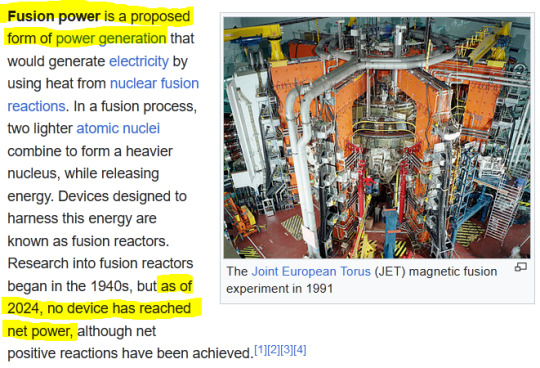
TL;DR - as of April 2024, all fusion reactors as a matter of course still consume more power to run than they are able to produce (meaning they do not reach "breakeven"). Many cutting-edge reactors also require tritium (very rare) as well as deuterium (very common) fuel.
We did not even see a fusion reaction that reached "breakeven" for power production until December of 2022. That reaction occurred at the National Ignition Facility in California, and their results just passed peer review in February of this year (2024).
Several in-progress reactors aim to improve on this, including ITER (the combined work of dozens of nations) in France, and SPARC: the new reactor under development by Mass Fusion Commonwealth Fusion Systems and M.I.T.'s Plasma Science and Fusion Center (PSFC).
Another big problem with this technology is that it involves plasma.
Plasma, as a particular song reminds us, is what the Sun is made of and The Sun Is Hot. That means plasma carries some very real 'we're-losing-structural-integrity, the-warp-core-is-breaching' risks, and we must jump through all kinds of hoops to work with it.
Why are we shoving the Sun inside a donut, again?
The most well-funded, well-researched way of smashing atoms together involves plasma and magnetic confinement fusion.
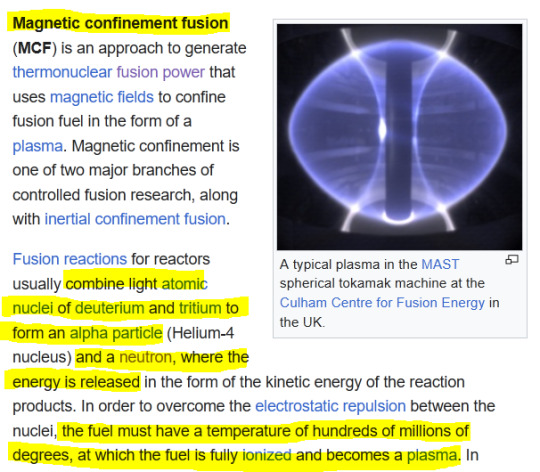
This shit is beyond cool. It may also look very familiar:
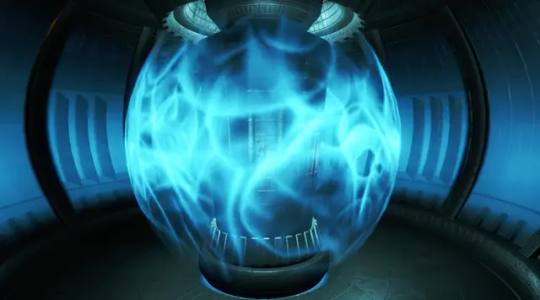
In-game, the Institute is trying to get what appears to be a spherical tokamak reactor up and running.
Bethesda's choice of reactor was no coincidence: M.I.T. operated the Alcator C-Mod, a spherical tokamak, while Fallout 4 was under development - but that reactor could not achieve "breakeven" IRL, and per Shaun's in-game dialogue, the fictional Alcator C-Mod couldn't either. (Weird given the miniaturized fusion devices everywhere in-universe, but okay, Shaun.)
However, M.I.T. stopped operating that reactor in 2016, a year after Fallout 4's release. SPARC, their planned replacement reactor actually has the sort of power potential we see in-game - and they aim to bring fusion power to market in this decade.
M.I.T., right now, in real life, is doing exactly what you're asked to help the Institute do in-game: build a fusion reactor that surpasses "breakeven."
What the hell is a tokamak and why does it look like half of a Star Trek warp core?
Your typical tokamak reactor is a great big donut-shaped vacuum chamber (the torus), traditionally surrounded by AT LEAST three sets of electromagnets (sometimes many more). M.I.T.'s design for the new SPARC reactor is a bit different, but let's start with the basics.
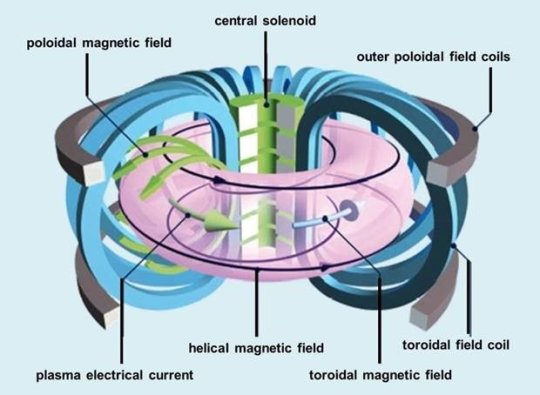
Why so many magnets?
Because plasma, being Literal Sun Matter, cannot come into contact with the torus containment walls or it will instantly burn through. (This happened in France in 1975. Following initial "well, fuck"s and a couple years' repairs, the logical next step was to publish a paper about it.)
The magnetic fields work to heat the plasma and provide current drive (keep electrons moving in a consistent direction through the plasma and around the torus), while also keeping it from touching anything, preventing a "warp core breach." I'll take a stab at explaining it but the Department of Energy probably does it better.
Meet the magnets:
Toroidal field magnets (blue, above): These enormous D-shaped magnets wrap around and through the torus, conducting an electrical current. This creates a magnetic field that keeps plasma from drifting horizontally into the containment walls.
Central solenoid (green, above): Inside the "donut hole" sits a massive, stacked electromagnet that generates enough electromagnetic force to launch two space shuttles at once. This heats the fuel to about one hundred million degrees Celsius so that it reaches plasma state, and helps "drive" the plasma current around the torus. (Radiofrequency or neutral beam injection heating/drive may be used as well for reactor prototypes aiming for power generation, because current drive from just the solenoid isn’t practical for continuous operation.) The central solenoid also creates another magnetic field called the "poloidal field," which "loops" around the plasma like a collar to prevent it from drifting vertically into the walls. The strongest central solenoid in existence was made for the ITER reactor...by General Atomics.
Outer poloidal field magnets (grey, above): A third set of electromagnets "stacks" up the outside of the torus, and helps maintain and adjust the poloidal field.
Together these three sets of magnets force the plasma to "float" inside the torus, shape it, and provide current drive. The stronger the magnetic field, the higher the reactor's power output.
Okay, and then what?
Given sufficient heat and drive/stability, the plasma fuel mixture undergoes fusion.
Neutrons released during fusion have plenty of kinetic energy (the kind of energy a kickball has midair before it hits you in the face), but no electric charge.
Since magnetic fields only affect negatively or positively charged particles, neutrons completely ignore the fields, sailing straight through and slamming into a "blanket" of metal coating the donut's insides. Neutrons passing into the 'blanket" lose their kinetic energy, which is converted to heat and absorbed by the "blanket." (ITER's "blanket" involves a lot of beryllium, which...behaves a bit differently IRL than it does in-game.)
Heat captured by the "blanket" is then used to generate power. For instance, a water cooling system can bleed heat from the "blanket," regulating temperature and creating superheated highly-pressurized steam to run turbine generators.
I notice you described a "typical" tokamak above -what's the atypical option?
Check out SPARC.
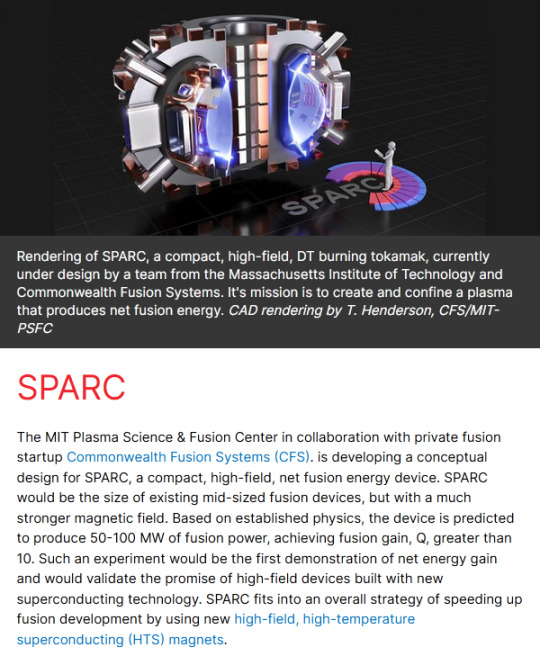
Its huge design departure is that it uses new high-temperature superconducing magnets (most existing types have to be cooled to vacuum-of-space temperatures using something like a liquid helium system to achieve superconductivity, which is a huge power drain) to create a monstrous magnetic field - and its size is tiny in comparison to its projected power output.
Neat. So why did you refer to plasma as a problem?
Well...between the heat and the neutrons, the "blanket," the "first wall" and all plasma-facing surfaces inside the torus take one hell of a beating:

"Neutron degradation of wall surfaces-" "Energy is released in the form of the kinetic energy of the reaction products-" In practical terms, that just means countless neutrons are doing THIS:

...but to the containment wall and other surfaces inside the torus, instead of to Batshuayi's face. And so:

Basically, this stuff breaks fast enough - and the only materials that don't break quickly are rare enough - to create a real barrier to commercial use.
And THIS is one of the problems they're working on solving in M.I.T.'s basement.
Now we can talk about the Vault. FINALLY.
M.I.T. is home to the Center for Science and Technology with Accelerators and Radiation (CSTAR). CSTAR's splash page announces:
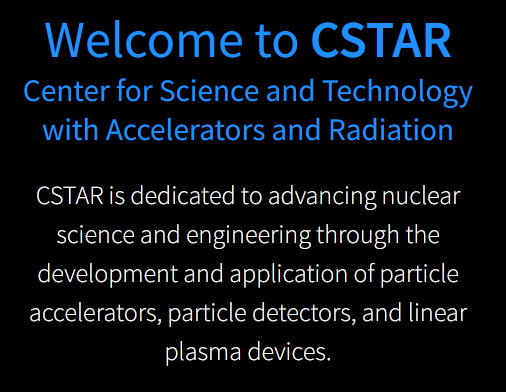
Linear plasma devices? You mean like -
No, not like plasma rifles. Instead of weapons, we're talking about tools being used to solve the "plasma fucking destroys everything it touches" problem.
How does CSTAR do this? They've got CLASS. ...No, really:
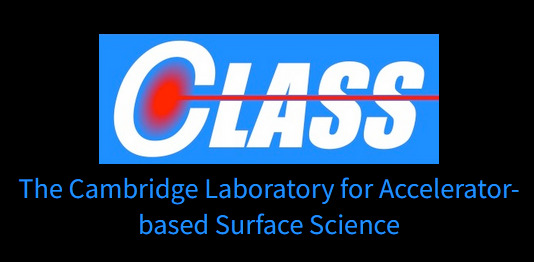
This field is called plasma-surface interaction science, and if you want a really long but very informative read on how CSTAR's work helps move it forward, check this out. It involves the DIONISOS Linear Plasma Device - a "let's shoot it with plasma and see what happens" tool.
CSTAR also works to better undertstand how materials handle radiation damage, and how they behave after becoming irradiated.
And to handle this sort of work, one needs a...
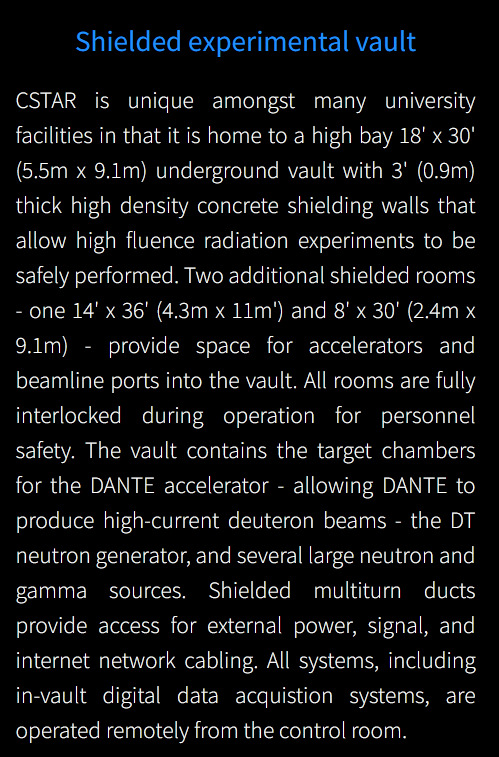
The Vault Laboratory for Nuclear Science "combines high-intensity particle sources, precision particle detection, and a heavily shielded experimental area to create a facility for nuclear research in high-radiation environments." It contains, among other things:
the DT Neutron Generator, which is used in a variety of experiments, including radiation detector development (pretty damned important) and characterization, fast neutron imaging, and material activation (stuff becoming radioactive).
the DANTE Tandem Accelerator, which was "originally designed to produce high neutron yields for use in cancer therapy research."
And that is what's actually going on in M.I.T.'s basement: truth is cooler than fiction.
The takeaways:
Yes, M.I.T. really is building a revolutionary fusion reactor with parts from Mass Fusion Commonwealth Fusion Systems.
Yes, there really is a secure underground facility where incredibly advanced research related to nuclear fusion, radiation detection, irradiated materials, and degradation of materials due to radiation exposure takes place.
Yes, I really would spend eight hours researching nuclear physics instead of doing more dishes. Shoutout to @twosides--samecoin for tolerating my absurd hyperfocus on researching this.
Thanks for coming to my TED talk on what M.I.T. is really doing in its basement.
Tune in next time for M.I.T.'s Media Laboratory, and how it is related to real-world power armor, plus: the relationship between Langley, P.A.M.'s IRL cousin, and Vault 101.
** (Fallout is wildly inconsistent re: how widespread fusion is in-game and when it was developed. I mean we're talking a two-decade spread of inconsistency! And somehow the technology - first available to the military - was then miniaturized and made available to the general public before becoming widespread for commercial power generation? And somehow we both do and don't have impossible cold fusion in game? It's a mess. I reject this reality and replace it with a fish, hence this post. Also, I hate fission batteries. don't talk to me about fission batteries, "fission batteries" are small fission reactors but they are definitely not "battery sized" - the "fission batteries" in-universe are so miniaturized that they are more likely another kind of atomic battery like a radioisotope thermoelectric generator and those are subject to a law of diminishing returns as the fuel decays/not producing a reasonably useful power output after over 200 years due to the isotopes normally used/can be VERY dangerous if the shielding is breached or removed, and - you know what, that's also a whole different post.)
49 notes
·
View notes
Text

A Capacitor is an electric component formed by two electrical conductors separated by an insulating material. Multilayer ceramic capacitor (MLCC) consists a number of layers of ceramic inner electrodes in a sandwich structure. MLCC is a surface-mounted device (SMD) capacitor, which is used in a wide range of capacitance applications such as telecommunications, data processing, PCs, hard disks, game PCs, DVDs, video cameras, mobile phones, general electronic circuits, and others.
0 notes
Photo

The adoption of a memory should lead us to spend reflex in the brain act itself. We have in this case reached the automatic reflex as it is found in the dog Piraux as well as turtles Grey Walter, the perception Commander automatically action, as well as in the human reflex we know that the perception does not go to the brain: in the spinal cord itself is in fact a summary of the present and the past, its behavior depending what he sees and what he has seen. Thus it is apparent that we reproduce a model elementary artificial brain true if one was sure that at any moment the decision is a result of complex sensory impressions of this cutting and memories stored in a memory , and it is this problem that we tried to address with the fox-mail.

The anatomy of the motor is classic. Three-wheeled support it based on the model of tricycle, the front wheel is director and Driving while "taking turns" are associated with one of the rear wheels. And the front wheel is below the neck of the animal, the latter bearing at the end of an insulating support a set of bodies constituting the head of the fox. The head in question has a field of exploration of 180, demanding course that the engine is crawling with an inverter walk. The order is automatic when the head is at the end, completely turned to the right or left, or when the animal is in a period of exploration, an obstacle comes oppose the lateral movement of his head. As for the running engine mounted on the front wheel, we have chosen powerful enough because of both the relatively high weight of the fox (4 kg) than in the interest of obtaining a device with no moving too slow to that the observation is not tedious. The capacity of batteries is modest (8 volts; 6 AH), but luckily this engine running works only so discontinuous: when drilling, the total consumption of the fox is in the order of only 1 amp, and it even fewer in times of "reflection".
In this case, the basic body movements deciding fox is a "reverser system" that directs the flow of battery to the motor running or sends in a circuit where the engine is mounted exploration in series with another engine, said "character", which we will shortly explain the role. Such an inverter system is obviously controlled by a relay inserted at the exit of the posts that make up the electronic brain of the fox.
This one is fed by the circuits from the sensory organs, according to a "combination" as broad as possible impressions gathered. Admittedly, it may not be complete. Suppose that the fox advance in a certain direction and that Suddenly be an obstacle placed in his path: he must necessarily stop. This means that the tactile sense is "priority" over others. That was the formula adopted in all the past achievements. On the contrary, for the hearing and sensory impressions, it is mechanically possible for the animal to walk as well as to explore. In other words, if we consider the five senses that owns the fox, the combination may only refer to three of them, the tactile sense to be a completely autonomous circuit, while the flair we have adopted an intermediate. Such a situation is not devoid of interest: the combination of impressions from three senses is indeed a complex reproducing judgment. For example, assume that the fox track and a light comes up in a state such as a current 0.51 milliamp circulated in the relay. Accepting that this relay has been closed and it opens to a current of 0.50 milliamp, it will remain closed. The animal has "decided" to walk, but only just a little intense it will indeed be able to bring down the current plate momentarily below 0.50 milliamp, and the relay will then remain open, because for the "close "a current of 1 milliamp is necessary. The "critical areas' of his behaviour and lie around 0.50 and 1 mA, amplifiers have been resolved in such a way that these areas may correspond to" case "easily achieved in practice. In addition, regardless of the concept of judgement, we can say that the tactile sense ensures reflex, ie, as in higher organisms, the behaviour of both the fox depends reflex that acts brain. In practice, the five senses were made in the following manner: 1. The view is provided through two photo electric cells fitted with blinkers. Through this way, the sensation is not the same with a light four times more intense, at a distance twice less, as would be the case with a single cell. In other words, it can be argued that this gives to some extent the fox the perception of the terrain. 2. Hearing consists of a microphone, it is a rudimentary model, but sensitive, with a pellet shot at using the current Battery and feeding a transformer coupled to an electronic amplifier. 3. A sense of direction is represented by a potentiometer housed in the neck of the animal. He then brought to the polarization of a certain lamp L ', while the sight and hearing are ordering the lamp L, the main one being sensitive relay inserted in the circuit plate Joint L and L'. We see that this assembly performs well a combination of three types of sensory impressions so far considered. 4. The touch is ensured by the papillae tactile housed in the head, the animal it is that close contacts as soon as a body outside touch this head. The contacts in question were inserted into a circuit directly controlling the inverter system. 5. The flair is a metal plate which forms the nose of the fox, the principle being that the papillae capacitive raised about Miso. The Capacitor they excite a relay special command that may act on the reverser system like the taste of contact, but this relay is also linked to the "post character." [Note RH – This is the so-called “sense of smell” – not real smelling at all.]

THE MEMORY AND CARACTÉRIEL INTEGRATIVE However, under the previous scheme we have not yet seen the memory integrative, element number 1 of the Act cerebral. Note well what fundamental difference between memory and integrated memory simple, commonly known recording. This formula corresponds to the recording of a sequence of signals on any media, as a result of which there will subsequently recover from this simple scroll which we find illustrated both with the wire with the conventional magnetic disk phonograph. Instead, the memory is a true integrative synthesis of memories: one can, in this case, imagine under the appearances of a surface initially plane, in which the various events just make as many small deformation. Thus all the events in which man has witnessed since its birth as they mark his mentality can be achieved by the appearance of its surface mnémique as a result of all its strains, each of which has been forgotten in detail. Thus with the character that we tried to reproduce such a principle integrative memory. It is, as we have said, with an engine of exploration, and so is likely to be turned on whenever the sensory impressions of fox reach the threshold of excitement that toppled the regime reverser. This engine is in this case coupled with a knob that controls the voltage of the grid auxiliary tube '. If this tension is very high, the current passes through L ', even though the main gate is biased negatively. Instead, a low voltage of the auxiliary gate has the effect of blocking L '. Through this mechanism, it appears that the sensory impressions at the same time they control the movement of foxes change the setting of its amplifiers, ie, faced a similar situation, his behaviour is not the same from one day to another, since the fox has "lived" in the meantime. However, we felt it appropriate that this character is not turned on at all times. To this end, we did it depend on a command post capable of short-circuiting. He makes himself the synthesis of several phenomena, it depends on three contacts controlled by the movement of the character itself (which means that, in itself, the character hangs at the end of a time Operating determined), by the movement of fox (an inverter is controlled by the rear wheels), with the relay of Inductor. When the character is action, the sensitivity of the fox is changed, and we can say that it is varied. On the contrary, when it is short-circuited, the character is fixed, or at least can no longer mention that "variations in mood," according to the voltage of the batteries. This tension, which directly controls the polarization of light ', is indeed a function of the state of discharge of batteries that the energy required by the engines and various windings. If the decision by the fox to a given situation represents a synthesis of the present and the past, it should be noted that the "weight" of the past is variable depending on the position of the head. We have in fact indicated that the movement thereof acts on a potentiometer commander lamp L ', the sensitivity of the tube being so great when the head is right, and on the contrary low if the head is completely turned to the right or left. Similarly, it appears that, depending on the individual, the burden of the past is more or less depending on their temperament all levels with the possibility of hedonistic while the contemplative, for a given individual, the part of the past also varies depending on the circumstances. So when the fox look straight ahead, can we say he lives primarily on his memory, especially as he takes on his perceptions when his head is turned. A DISCONTINUITÉ OF PERCEPTION Worth noting simply, without discussing this issue here, we wanted to introduce a cell of imagination in this fox, as he speaks for binary through two bulbs green and red respectively worn by her head. But above all, we tried to reproduce a further analogy with the human brain by adopting the principle of a perception discontinuous, this discontinuity is of a paramount importance to us, In this case, our brain can be considered as a working machine in a vacuum, except during short intervals which are repeated at a rate of 10 to 12 per second, during which information is collected specifically in our cerebral areas. Moreover, this rate though we explained our eye sees the images if they succeed because of Brettermeier per second, while over a dozen is the cinema, and similarly our ear perceives sound if noises successive obey a similar law. In fact, it is neither our eye or our ears that need to be blamed, but rather the brain, the latter taking cognizance of the world in order to change discontinue its work in the light of new information received. To achieve such a discontinuity in the fox, we have called these comptetours "solidarity" with a rear wheel, which he had previously discussed. Thus, a contactor primary is closed all three rounds, which blocks a relay memory likely to be released only if a cause affects the movement of the head. On the other hand, a contactor school is closed all six rounds. However, the closure of these two contacts has the effect of bringing Engine exploration and character, while everyone's perceptions are cut, this state of affairs remaining until one of the two contacts is open. This happens in practice if the head hits an obstacle side or, at the end of the course, ie when the head turned completely on the one hand, is required to change its sense of exploration. At that moment, the fox sees the outside world with a new spirit, as we pointed out that it is precisely at the end of the race that the weight of the past is minimal …

If the fox claims reproduce the basic characteristics of cerebral work, understand that it is a "model" Basic reduced, both at the perception that the trial: two photo electric cells appear in effect Accessories well as poor against the 140 million cell door as our retina. And on the other hand, it is assumed that our brain has about 10 billion neurons! As such, there is no doubt that we have barely glimpsed the fantastic opportunities that lie ahead. And indeed, in the past, many manufacturers have shown us automates all the subtlety of behaviour that may be expected from a machine if you have the patience to develop it accordingly. The prestigious name of Vaucanson is there, with its wonderful machines: if we consider only a "wing" of the famous duck, we must not forget that it incorporated elements 400, while the same Vaucanson knew how to build representation " Cleopatra "Marmontel a snake that s'élançait across the stage whistling and went with astonishing precision drill with the queen. And manufacturers automata unaware that agent wonderful electricity soul of sensory organs and today's engines! One might ask what machines they would have done with the resources of modern electronics. In fact, the technique we now enter an era of genuine "electronic watches" where one can build tubes the size of a pea, before tomorrow transistors big as a phonograph needle. In the electric shows, we can see no other an electric motor and a battery offering 1 single aspect of pellets? Under this sign, it is hoped to build tomorrow's electronic brain the size of a human brain, ie true miracles are to be expected in terms of electronic animals, beyond which our current DIY appear in a Poverty disconcerting. As to the desirability of such animals artificial, it seems considerable. First theoretical usefulness is real, real machines analogies allowing us the most interesting studies on the functioning of our nervous system. Importantly, we believe qu'inéluctablement, besides calculating machines and electronic brains ever more complex over which man relies more and more to solve a growing number of operations intellectual grounding peuplera tomorrow ' a large number of robots that are able drive: extending the wording of these artificial animals, they represent a people capable of slaves' to perform all tasks material which man will hear the charge, under the species of The most diverse races …

2 notes
·
View notes
Text
TAFAKKUR: Part 330
OLFACTION: SENSING THE SCENTS: Part 2
E-NOSE TECHNOLOGIES
The sensor is the e-nose's key element, and the sensor type is its defining characteristic. There are 5 types of e-nose sensors, as follows:
Optical sensors: Optical fiber sensors work through fluorescence and chemoluminescence. The tube's glass fibers contain a thin encoated active material in their sides and at both ends. As VOCs interact with the organic matrix's chemical dyes, the dye's fluorescent emission changes the spectrum. These changes then are measured and recorded for different odorous particles.
Fiber arrays with different dye mixtures can be used as sensors. These are fabricated by dipcoating (binding a plastic solution to a substrate), micro electromechanical system (MEMS), and precision machining. The main advantage is that this adjustable tool can filter out noise. Also, since many dye forms are available in biological research, sensors are cheap and easy to fabricate. But the instrumentation control systems are complex, which adds to the cost, and have a limited lifetime due to photo bleaching (the sensing process slowly consumes the fluorescent dyes).
Optical sensors are sensitive and can measure low ppb (parts per billion); however, they are still in the researach stage of development
Spectrometry-based Sensors: This group consists of a molecular spectrum-based gas chromatography (GC), an atomic mass spectrum-based mass spectrometry (MS), and a transmitted light spectrum-based light spectrum (LS). The first two can analyze the odor's components accurately, which is a plus. However, their use of a vapor trap to increase concentration can alter the odor's characteristics. LS devices do not consume the sample, but do require tunable quantum-well devices. GC and MS devices are commercially available, while LS devices are only at the research stage. All spectrometry-based sensors are fabricated by MEMS and precision machining, and can measure odors to a low ppb level.
The GC tube decomposes the odorant into its molecular constituents, and MS forms a mass spectrum for each peak. The spectra then is compared to a large precompiled database of spectral peaks to classify and identify odorants.
MOSFET (Metal-oxide-silicon field-effect-transistor): The basic principle here is capacitive charge coupling. In other words, VOCs react with the catalytic metal and thereby alter the device's electrical properties. The device's selectivity and sensitivity can be fine-tuned by varying the metal catalyst's thickness and composition. MOSFETs are micro-fabricated and commercially available, but can measure only parts per million. They can be manufactured by electronic interface circuits, which minimizes batch-to-batch variation. However, the gas produced by the VOC-metal reaction must penetrate the MOSFET's gate.
Conductivity Sensors: The sensor types used here are metal oxide or conducting polymer. Both operate on the principle of conductivity, for their resistance changes as they interact with VOCs. Metal oxide sensors are common, commercially available, inexpensive, and easy to produce (they are micro-fabricated). Their sensitivity ranges from 5-500 ppm. However, they only operate at high temperatures (200°C to 400°C).
In conducting polymer sensors, VOCs bond with the polymer backbone and change the polymer's conductivity (resistance). They are micro-fabricated together with electroplating and screen printing, are commercially available, and can measure from .1 to 100 ppm. They operate at room temperature, yet are very sensitive to humidity. Moreover, it is hard to electropolymerize the active material, which makes batch-to-batch variation inevitable. Sometimes VOCs penetrate the polymer chain, which means that the sensor must be returned to its neutral and reference state-a very time-consuming process.
Piezoelectric Sensors: These devices, which measure any change in mass, come in two varieties: quartz crystal microbalance (QCM) and surface acoustic wave (SAW) devices.
QCM sensors have a resonating disk and metal electrodes on each side. While applying the gas sample to the resonator's surface, the polymer surface absorbs VOCs from the environment. Thus its mass increases, which increases resonance frequency. As the U.S. Navy has long used QCMs, this technology is familiar, developed, and commercially available. A QCM sensor is fabricated by screen-printing, wire bonding, and MEMS. Althoug it can measure a 1.0 Ng mass change, its MEMS fabrication and interface electronics is a major disadvantages. QCM sensors are quite linear in mass changes, their sensitivity to temperature can be adjusted, and their response to water can vary for the material used.
MEMS techniques should be handled carefully, for the surface-to-volume ratio increases drastically as dimensions approach the micrometer levels. Measurement accuracy is lost when the increasing surface-to-volume ratio begins to degrade the signal-to-noise ratio. This problem occurs in most micro-fabricated devices. SAW devices have much higher frequencies. Since 3-D MEMS processing is unnecessary, SAW devices are cheaper. As with QCM devices, many polymer coatings are available. The differential devices can be quite sensitive. However, interface electronics require more complex electronics than those of conductivity sensors for both QCM and SAW sensors. Also, as the active membrane ages, resonance frequencies can drift and so must be detected for frequency by time. SAW devices are commercially available and sensitive to mass changes at the 1.0 pg level.
PATTERN RECOGNITION
Any e-nose's primary task is to identify an odorant and perhaps measure its concentration. After the signal processing step comes the crucial step of pattern recognition: preprocessing, feature extraction, classification, and decision-making. A database of odors must be formed for comparison purposes.
Preprocessing accounts for sensor drifts and reduces sample-to-sample variation. This can be done by normalizing sensor response ranges, manipulating sensor baselines, and compressing sensor transients.
Feature extraction involves dimensionality reduction, a crucial step for statistical data analysis, since the database's examples usually are subject to financial constraints. The higher dimensionality caused by sensor arrays is reduced to relevant pattern-recognition information and thus extracts only significant data. As most dimensions are correlated and dependent, it is better to reduce dimensionality to a few informative axes.
Feature extraction usually is accomplished by classical principal component analysis (PGA) or linear discriminant analysis (LDA). PCA is a linear transformation that finds the maximum variance projections and the most widely used technique for feature extraction. But as PCA ignores class labels, it is not an optimal technique for odor recognition.
LDA seeks to maximize the distance between class label examples and minimize the within distance, and thus is a more appropriate approach. LDA is also a linear transformation. For instance, LDA might better discriminate subtle but crucial odor projections, whereas PCA can remove the high variance random noise in a projection.
The classification stage identifies odors. Classical classification techniques are KNN (k nearest neighbors), Bayesian classifiers, and ANN (artificial neural networks]. KNN with, say, 5 nearest points will find the 5 closest matches from the precompiled database. The closest match will be assigned as the tested material's odorant class.
Bayesian classifiers first assign a posterior probability to the classes in the lower dimension and then pick the class that maximizes the predetermined probability distribution. ANN is closer to biological odor recognition. After being trained by the odor database, it is exposed to the unknown odorant in order to recognize the largest applicable response odorant class. The classifier estimates the class and places a confidence level on it.
In decision-making, risks and application-specific knowledge are considered in order to modify the classification. All decisions are reported-even a nonmatch.
CONCLUSION
As this article indicates, we can expect great progress in this area. And with each step forward, science and technology will continue to point toward the Greatest Artist's most subtle designs and allow us to appreciate them better.
#allah#god#prophet#Muhammad#quran#ayah#islam#muslim#muslimah#help#hijab#revert#convert#religion#reminder#hadith#sunnah#dua#salah#pray#prayer#welcome to islam#how to convert to islam#new convert#new muslim#new revert#revert help#convert help#islam help#muslim help
1 note
·
View note
Text
Obsolete Electronic Component Types

Obsolete components distributor are the building blocks of modern technology. They enable devices to process information, communicate with other devices, and perform a wide range of functions. However, as technology advances, certain electronic component types become obsolete and are replaced by newer, more efficient ones. Here we'll explore some of the most common obsolete electronic components types and their replacements.
1. Vacuum Tubes
Vacuum tubes were the earliest obsolete electrical components and were widely used in the first half of the 20th century. They are essentially glass bulbs containing a vacuum, with metal electrodes inside. Vacuum tubes were used in radio and television receivers, amplifiers, and early computers. However, they were large, fragile, and consumed a lot of power. As a result, they were gradually replaced by obsolete electronic parts, such as transistors. GreenTree Electronics is one of the best obsolete electronic components distributor and provides advanced electronic parts.
2. CRTs
Cathode ray tubes (CRTs) were widely used in older televisions and computer monitors. They work by using an electron gun to fire a beam of electrons at a phosphor-coated screen. The beam of electrons creates an image on the screen. However, CRTs were bulky and heavy and consumed a lot of power. They were replaced by LCD and LED displays, which are lighter, more energy-efficient, and produce sharper images.
3. Floppy Disks
Floppy disks were widely used in the 1980s and 1990s as portable storage mediums for personal computers. They were small, lightweight, and could store up to 1.44 MB of data. However, they were slow and unreliable, and as storage needs grew, they were replaced by CDs, DVDs, and USB flash drives, which offer much higher storage capacities and faster read and write speeds.
4. Electrolytic Capacitors
Electrolytic capacitors are used in electronic circuits to store electrical charge. However, they have a limited lifespan and can dry out over time, leading to a loss of capacitance and an increase in internal resistance. As a result, they are gradually being replaced by ceramic capacitors, which are more reliable and have a longer lifespan.
5. DIP Packages
Dual in-line package (DIP) components were widely used in the 1980s and 1990s, especially in microcontrollers and other digital circuits. However, as the size of electronic devices has shrunk, DIP packages have become too large and are being replaced by surface mount technology (SMT) components, which are smaller, lighter, and more suitable for compact devices.
Electronic components have come a long way since the early days of vacuum tubes. As technology advances, obsolete integrated circuits comes in more efficient ones. While this can be frustrating for those who still have older devices, it's a necessary part of progress and enables us to enjoy the many benefits like distributor of IC’s of modern technology.
0 notes
Text
Price: [price_with_discount] (as of [price_update_date] - Details) [ad_1] From the manufacturer Compatibility Tech Specs Disc Material: Transparent Plastic Pen Body: High Quality Aluminum Alloy Length: 6.1 Diameter: 0.35 Convenient Features Magnetic tic cap - easy to handle the product Extra tip – as a backup. MAGNETIC CAP FINE TIP EASY TO USE NO NEED OF CHARGING High Sensitivity Precision Mobile Phone Stylus : Gives Smooth Easy & Accurate Experience While Writing Painting Making Notes . You Can Also Navigate The Pages With Comfort This Touch Screen Pencil Tip Are Clear & Fine For A More Quiet And Accurate Writing Experiance Compatibility: Fully Compatible Disc Stylus This Tab Pencil Stylus Can Be Used On Universally Almost All Capacitive Touch Screens Mobile Cell Phones Or Tab Including Apple Ipad, Iphone 12 Max Pro / Xr , Samsung Galaxy & Other Android Devices This Is A Non Electronic Based Product No Need For Batteries. Its A Pen For Ipad Or Galaxy S Pen Stylus Pen For Iphone Replaceable Tips - The Stylus Pencils Come With 1 Spare Disc Tip. So No Worry To By Another Replacement Disk its a non electric based stylus pen its not a apple pencil Non Electronic Stylus Pen Or Stylus Pencil For Touch Screen With A Magnetic Cap And Clear Disc Tip For Touch Screen : Magnetic Cap Will Get Fixed On Both End Of This Pencil Aluminum Alloy Materials Makes It Strong And Provides Maximum Protection And Durable And Convenient To Use . Please contact brand customer care 7270000727 for any warranty claims [ad_2]
0 notes
Text
What is STONE HMI?- human interface with TOOLBOX sofawsre
An HMI, also known as a human interface, is a display that allows a user to control and monitor his or her machine.A common example of an HMI is an ATM machine, coffee machine, or beauty machine on which the user can interact with the machine using screens and buttons.
Today, through this guide, we will introduce:
Introduction to HMI
HMI and STONE
Why use STONE HMI
STONE HMI display
STONE display starter
HMI project concept
Introduction to HMI - human interface
A human interface is a component of certain devices that allows the user to interact with the machine.
The interface consists of hardware and software that provide information to users by allowing them to input signals that are converted into machines.
Information including temperature, pressure, speed, time, battery and so on!
The interface can also have a variety of forms and sizes, including: 3.5 ', 4.3 ', 5 ', 5.6 ', 5.7 ', 7 ', 8 ', 9.7 ', 10.1 ', 10.4 ', 12.1 ', 15.1 '.
With HMI, you can closely monitor the machine and control and maintain it.This, in turn, can improve efficiency, diagnosis, and monitoring.
One of the biggest benefits of HMI is the user friendliness of the graphical display.You can add colors and images to easily and quickly identify problems.
You can use an HMI almost anywhere you need human intervention with a machine or automated device.For example, you can use them with medical beauty equipment, 3D printers, engineering projects, automobiles, etc.
HMI with STONE
Reference: STONE
STONE provides intelligent HMI solutions.Any smart TFT LCD module with an MCU (with a cortex-m4 32-bit CPU) can be controlled with simple hexadecimal instructions via the UART port.
The module consists of CPU, TFT drive, flash memory, UART port, power supply and so on.STONE also provides basic controls and powerful design software (STONE TOOL Box).
You can use the STONE TOOLBox software to set up various functions on the graphical user interface, such as text, graphics, curves, image switching, keyboard, progress bar, slider, dial, clock and touch buttons, data storage, USB download, video and audio.
Engineers can easily develop the tft-lcd color user interface and touch control features, which can reduce a lot of development time and cost.
STONE is mainly used in the field of industrial electronics.It is the best solution to replace the traditional LCD and LED digital tube.
You can easily connect the STONE HMI display via TTL serially through its peripheral MCU to provide event notifications that the peripheral MCU can execute.
With the STONE HMI display TTL serial interface, you can easily connect them to microcontrollers like STM, RAM MCU, Arduino and Raspberry Pi, or any system that can communicate via serial ports.
Why use STONE HMI
Easy to use
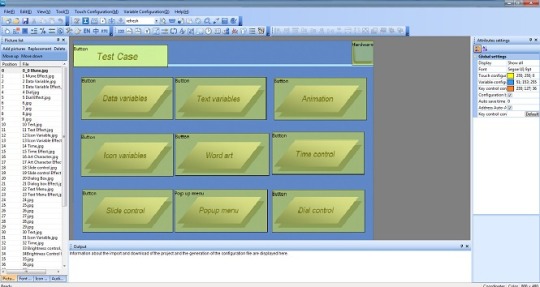
STONE TOOLBox软件
First, STONE is easy to use.With the STONE STONE TOOLBox software, you can easily create intuitive touch user interfaces, even if you're a beginner.
For example, by adding a static image as a background and defining functionality by component, you can easily and quickly create a simple GUI in just a few minutes.
With drag-and-drop components and simple instructions, you don't have to spend a lot of time on HMI project development.
Cost-effective
Engineers can easily develop the tft-lcd color user interface and touch control features, which can reduce a lot of development time and cost
The products are divided into three series, the advanced series for medical beauty, the industrial series for industrial electronics, and the lowest price for civil use.According to their own needs, choose the right type of screen.
Varieties
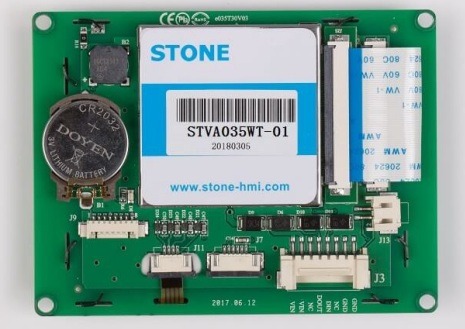
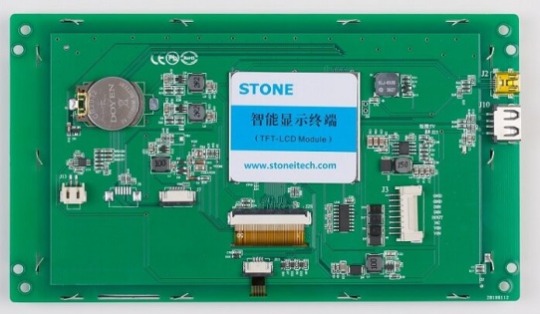
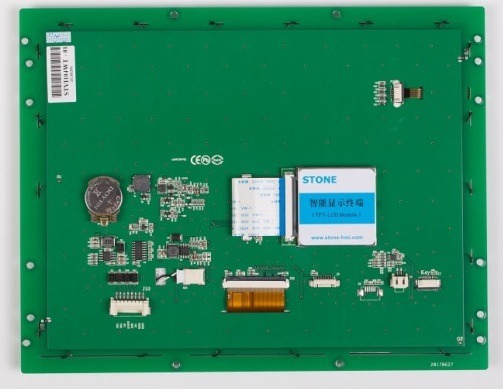
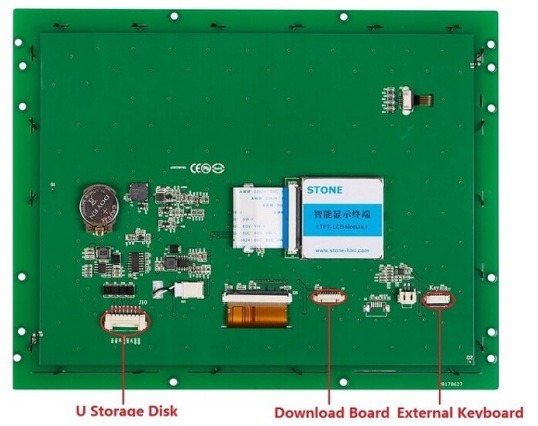
STONE HMI触摸屏
Various TFT LCD touch screen sizes from 3.5 inches, 4.3 inches, 5 inches, 5.6 inches, 5.7 inches, 7 inches, 8 inches, 10.1 inches, 10.4 inches, 12.1 inches, 15.1 inches, there are many models and options for the same size. With so many HMI displays, you are sure to find the best display for microcontroller projects like STM, RAM, Arduino and Raspberry Pi.。
STONE Support
Need help or technical help with your HMI project?Don't worry, STONE can provide technical support.
Optional UART interface type (RS232/RS485/TTL)
Optional touch control type (resistive/capacitive/non-touch)
STONE HMI Display
Industrial Type
Size Model Brightness Resolution View Area (mm) Voltage(V) Interface 3.5" STVI035WT-01 400 cd/m2 320x240 70.1x53.9 DC6.0-40 RS232/USB 4.3" STVI043WT-01 400 cd/m2 480x272 95x53.9 DC6.0-35 RS232/USB 5" STVI050WT-01 400 cd/m2 480x272 110.9x62.8 DC6.0-35 RS232/USB 5" STVI050WT-03 400 cd/m2 800x480 108x64.8 DC6.0-35 RS232/USB 5.6" STVI056WT-01 300 cd/m2 640x480 112.9x84.7 DC6.0-40 RS232/USB 7" STVI070WT-01 400 cd/m2 800x480 154.1x85.9 DC6.0-35 RS232/USB 7" STVI070WT-03 500 cd/m2 1024x600 154.1x85.9 DC6.0-35 RS232/USB 8" STVI080WT-01 400 cd/m2 800x600 162x121.5 DC6.0-40 RS232/USB 8" STVI080WT-03 400 cd/m2 1024x768 162x121.5 DC6.0-40 RS232/USB 10.1" STVI101WT-01 500 cd/m2 1024x600 222.7x125.3 DC6.0-40 RS232/USB 10.4" STVI104WT-01 350 cd/m2 800x600 211.2x158.4 DC6.0-40 RS232/USB
STONE HMI LCD module specifications:
Cortex m4 CPU; • UART interface (RS232/RS485/TTL) ; • 256-byte register; • 128 kb variable memory; • 128 MB flash memory, expandable to 1 GB; • GUI design software; • The customized command set; • 8-channel curve trend chart memory; • extremely fast variable display response speed; • The single-page supports up to 128 display variables; • Integrated real-time clock RTC, • Touch buzzer sound function; • Support software 90 degrees, 180 degrees, 270-degree screen rotation, adjust the appropriate visual Angle;
STONE TOOL Box (free GUI design software):
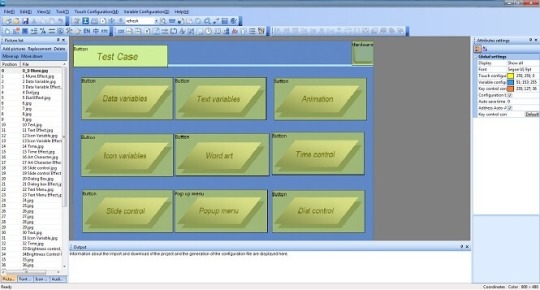
-- Free and easy to use STONE TOOL Box software
-- property value components that can be allocated at run time
-- Drag-and-drop components for GUI design and interaction
-- built-in debugger for HMI project emulation
STONE intelligent display module simple instructions:
UseTOOLS 2019 to design a GUI with any .jpg or .bmp image. 2. Use the UART interface (RS232/RS485/TTL) to communicate between the display and your MCU. 3. Use any language to write a simple program for the MCU, let it send the customized hex command sets to read or write the variable value of the display.
STONE LCD sample for developing:
For example: display the time variable "08: 30", and UART send the command: A5 5A 05 82 6F 00 08 30
Description:
A55A: Frame head 05: command byte length, 82 6F 00 08 30 total 5 bytes (excluding frame header) 82: write variable register command 6F 00: Variable address, set in control properties 08 30: data content, BCD code of 08 30
Package Including:
1 * STONE HMI 4.3" TFT 480x272 Resistive Lcd Touch Screen Intelligent Display Module
2 * Transfer board
2 * 8 pin terminal block
2 * 20mm long cable
1 * U disk
1 * USB cable
1 * 5mm short cable
1 * 20mm DB9 cable
STONE authentication and documentation:
- software
- editorial guide
- CE certification
- ROHS certification
- ISO9001 certification
- FC certification
STONE display starter
STONE consists of a hardware section (a series of TFT boards) and a software section (STONETOOL).
The STONE TFT board USES only one serial port for communication, thus avoiding wiring problems for users.
For the software part, STONE is rich in resources.
OSTONE - STONE TOOLBox is Windows software for GUI development.STONE TOOLBox has a number of components, such as buttons, text, progress bars, sliders, dashboards, and more, to enrich the interface design.In addition, drag-and-drop features reduce development effort by 99% by ensuring that users spend less time programming.With the help of this wysiwyg TOOLBox, designing guis becomes easy.
The STONE TOOLBox guide helps you easily set up the STONE TOOLBox.
O can communicate with STM, ARM, Arduino, Raspberry Pi.
The STONE TOOLBox guide helps you set up the STONETOOLBox software.
With these resources, I'm sure you'll have an easy experience on this monitor.
It is also easy to adapt the STONE series HMI to existing project users.You only need to provide one UART.
In addition, if you need any technical support when setting up the STONE display, you can contact STONE technical support.
STONE HMI Display Project idea
Here are some STONE HMI Display project ideas to get you started!
Use the STONE LCD module to create a refrigerator control
Reference: create refrigerator controls
Our fridge is not possible with any of the man-machine interface, but if there is a refrigerator with human-machine interface, let users can through the touch screen operation, control of refrigerator on the lower cooling efficiency, display the current the temperature inside the refrigerator, display the current indoor and outdoor temperature, and some feedback on the usage of refrigerator (days running, filter life, etc.), so, it is very convenient and practical for users.
What do you need?
Temperature sensor
Single chip microcomputer
STVC050WT-01for STM,ARM,Arduino Raspberry Pi general 5.0 inch HMI 480 * 272 touch display
Arduino IDEsoftware
STONE TOOLBoxsoftware
Running state includes:
Operation days
Filter element life
Outdoor temperature
Indoor temperature
To obtain these data, in addition to the first, the other three need the the corresponding sensor to collect these data. Filter element lifetime acquisition sensor and temperature sensor are required respectively. When the single-chip microcomputer collected these data, through the serial port to the designated display control address transmission data, the value of the display control on the corresponding change.
Running days can be implemented in two ways:
Use the RTC of STONE STVC050WT-01 serial port display screento display data directly on the screen
Use the single chip microcomputer's RTC to transfer data to the serial port screen for display
The STONE STVC050WT-01 serial port display comes with the RTC, which can be found in the STONE in development guide.
If you are interested, you can click: create refrigerator controlsSee the full tutorial!
STONE TFT LCD Module acceleration gyroscope sensor
With the STONE HMI display, you can now make an accelerometer gyroscope sensor. The accelerometer gyroscope sensor has the following functions:
Three text boxes display acceleration values
Three text boxes display the gyroscope values
Three text boxes display euler Angle values
A text box displays the current refresh time
Two buttons adjust the refresh time
What Do You Need
STONE advanced STVC070WT-01 universal 7-inch HMI touch screen
STM32F103RCT6 MCU
Mpu-6050 motion processing chip
Photoshop
Watch Dog
MPU-6050 Driver
Are you interested you can click Acceleration Gyroscope Sensor See the full tutorial!
Arduino uno + STONE LCD + Displays data read by MFRC522
reference:Displays data read by MFRC522
Due to my personal interest, I learned about the development of Arduino UNO and STONE LCD module project for two weeks, and found Arduino very simple, convenient and practical.So I wanted to do a simple demonstration with Arduino.I had an MFRC522 module at home, which I used in college, but I used STM32 to communicate with MFRC522, so I had to write my own driver for MFRC522 module, which was very complicated.
What Do You Need
STONE STVC050WT-01 display
Arduino UNO development board
MFRC522 module
Liquid crystal display
The MI card
Are you interested? You can go there https://www.stoneitech.com/news/sharing/how-to-display-data-read-by-mfrc522-through-stone-lcd-with-arduino.html Click to see the full tutorial!
LCD Arduino + STONE HMI +According to the heart rate
reference:instructables.com
Heart rate sensor module MAX30100 can collect users' blood oxygen and heart rate data, easy to use.
I found the MAX30100 library in the Arduino library file.That is, if you use communication between the LCD Arduino and the MAX30100, you can call the Arduino library file directly without having to rewrite the driver file.This is a good thing, so I bought the MAX30100 module.
I decided to use Arduino to verify the MAX30100's heart rate and oxygen collection capabilities.STONE TFT LCD screen for monitoring blood pressure.
What Do You Need
Arduino Mini Pro development board
MAX30100 heart rate and oxygen sensor module
STONE STVI070WT-01LCD serial display module
MAX3232 module
Are you interested you can click instructables.com See the full tutorial!
Conclusion
With STONE Display, you can now easily control and monitor STM, ARM, Arduino or Raspberry Pi machines, applications or device projects!Now, with the STONE STONE TOOLBox software, beginners can also create intuitive touch user interfaces.
What do you think of these STONE HMI displays?Let us know what you think of these STONE displays in the comments section below!
0 notes
Photo

Samsung ATIV Book 9 Plus (13.3” QHD+ Touch / Core™ i7)
We are holding special sales promotion For 2019's National Day in China now 1.You can get a third one for free as gift if you buy two phone together for same model (Buy two and Get Third one). 2.You can get 10% OFF discount for orders if you buy more than three items once ; 3.You can get 15% OFF discount for orders if you buy more than five items once . The Largest Marketplace of Electronics and Digital Products in China, We sell original Products with low price and quality wholesale goods, the item is discount for sale now, Best deals for Electronics from Trusted distributors: http://www.saleholy.com
Windows 8.1 (64-bit)
13.3” QHD+ (3200 x 1800) Touch Screen
Intel® Core™ i7 Processor / 256GB SSD
Ultra-thin and Light Design
About This Product Ultra-powerful Intel Core i7 Processor Pixel Perfection Sophisticated, Sleek Design Clear View with SuperBright™ Operating System Processor Category Usage Design Display System Memory Total amount of available memory may be less based on system configurations graphics support, and other factors. Storage Graphics ODD Sound & Camera Wireless I/O Ports Input Devices Power Security & Safety Method of protecting a computer's assets. A boot-password helps helps prevent unauthorized access. Included in Box Dimensions Weight Warranty Disclaimer
Crafted with power the ATIV Book 9 Plus' 5th generation Intel® Core™ i7 processor combines with 8GB of system memory to easily handle heavy loads of work and play, and a 256GB solid state drive gets you booted up and ready to roll in seconds. Intel HD Graphics built in for vibrant visuals and a smooth gaming experience. Watch video.
The ATIV Book 9 Plus packes 275 pixels per inch into its stunning 3200 x 1800 high-resolution display. The Quad HD+ touchscreen is 2.8 times sharper than Full HD and with true-to-life color SuperBright technology, it's a 13.3" eye-opening experience. When you can see more of every image—and more detail with incredibly high-resolution—you’ll enjoy less glare, better text clarity and content that’s easier to read and edit with pinpoint accuracy.
Made for mobility, the slim, lightweight award-winning ATIV Book 9 Plus measures just 0.54 inches thick and features a sturdy yet sleek aluminum body. Make a stylish statement while staying productive and connected on the go.
Bring everything to life with brilliantly clear and vivid pictures. The screen’s SuperBright technology generates 350 nit brightness, which is 75% brighter than a normal screen.* So your eyes feel less tired and information can be viewed from any angle within 178°.
Full Specifications
OS
Windows 8.1 Update (64-bit)
CPU
Speed (GHz)
Turbo Boost (GHz)
CPU Cache
Intel® Core™ i7 Processor 5500U
2.40 GHz
3.00 GHz
4MB L3
ATIV Book 9 Plus
Mobility, High Performance
Color Color of the casing that the laptop comes in.
Mineral Ash Black
LCD Size The diagonal measurement of a laptop screen, from corner to corner.
Type
Resolution
Touchscreen
Technology
Aspect Ratio
Brightness
13.3"
LED QHD+
3200 x 1800
Yes
Capacitive Touch
16:9
350nit SuperBright™ Technology
System Memory Total amount of available memory may be less based on system configurations graphics support, and other factors.
Memory Configuration
Memory Type
Max. System Memory
8GB
8GB x 1 (On Board)
DDR3L (1600MHz)
8GB
Storage Capacity Accessible capacity varies; MB = 1 million bytes, GB = 1 billion bytes, TB = 1 trillion bytes. Please note that a portion of the hard drive is reserved for system recovery, operating system and preloaded content software.
Storage Technology
Storage Interface
256GB
SSD
SATA3
Chipset Specialized CPU - in cell phones, computers, game consoles - that offloads graphics from a processor.
External or Integrated
Maximum Graphics Memory Storage that retrieves and modifies data in blocks, rather than individually, for optimal graphic performance.
Intel® HD Graphics 5500
Integrated
Shared
Optical Disk Drive Internal drive that uses laser light to read and write media on CDs, DVDs, and other disc formats.
None
Speaker Additional speakers that supplement or enhance the sound generated from a netbook's internal speaker.
Audio Type
Sound Effect
Web Cam Built-in, high-res camera above screen that enables user to video chat, conference, and upload clips.
Internal Mic
Stereo Speakers (2W x 2)
HD Audio
SoundAlive™
720p HD
Yes (Dual Array)
Wireless LAN Technology that links a computer to Local Area Networks (LAN) without wires, often for internet access.
Wireless LAN Antenna
Bluetooth®
WiDi
802.11ac
2 x 2
Bluetooth 4.0
Yes
VGA
HDMI High-Definition Multimedia Interface. Industry standard for transmitting HD video between components.
Headphone Out
Microphone In
USB Ports (Total) Universal Serial Bus. Interface standard for connecting peripherals to a computer. USB 2.0 is high-speed.
Sleep-and-Charge USB
Multi Card Slot
RJ45 (LAN) Terminal that is used to connect a computer to Local Area Networks (LAN) via an ethernet cable.
Yes (Available only with dongle sold separately)
Micro HDMI
Yes (Headphone/Mic combo)
Yes (Headphone/Mic combo)
2 x USB 3.0
Yes
3- in-1 (SD/SDHC/SDXC)
Gigabit Wired Ethernet LAN with included dongle
Touch Pad / Track Point Surface on keyboard (and monitor) that translates position of fingers to a relative position on screen.
Backlit Keyboard
Number of Keys
Touch Pad (Multi-Gesture Support)
Yes
80
AC Adapter
Number of Cells / Cell Type
mAh
Watt Hours
Battery Life *Battery life will vary depending on the product model, configuration, power management settings, applications used, and wireless settings. The maximum capacity of the battery will decrease with time and use. Test results based on independent third party Mobile Mark (or Battery Mark) tests. Non-Metric weights and measurements are approximate.
Test Used
40W
4 Cell / Li-Po
7300
55.5Wh
Up to 12.5 hours
Mobile Mark 2012
Security Slot Anti-theft system in which a key or combination lock and cable apparatus can attach to the computer.
BIOS / HDD Password
Yes (with slim type adapter)
Yes
Accessories
Software
AC Adapter LAN Dongle
Samsung SideSync 3.0 Samsung Link 2.0
System Dimensions (L x W x H, Inch)
12.58" x 8.78" x 0.54"
System Weight (w/Std. Battery, lb.)
3.06 lb.
Warranty
1 Year Standard Parts and Labor
Disclaimer
Battery life will vary depending on the product model, configuration, power management settings, applications used, and wireless settings. The maximum capacity of the battery will decrease with time and use. Test results based on independent third party testing.
0 notes
Text
An Amazing Water-Cooled PS4 – How to Build It?
Many enthusiasts look forward to get a water-cooled PS4 due to its vast benefit to their gaming. In fact, a PS4 liquid cooling doesn’t exist in the markets, but you may build one of it yourself. Maybe there’s some companies who offer this, but in general, it doesn’t exist. Additionally, if you own PS4 Pro, you may also want to get a PS4 Pro water cooling kit. This will lower the temperature of the PS4 Pro to the lowest and enhance your gaming experience with it. Moreover, a PS4 Pro liquid cooling is also one of the rare products in the markets.
So, let’s first get to know what the PS4 water cooler is and how does it work. Also, let’s go deeper into liquid cooling system in general to get better knowledge about that for PS4 and PS4 Pro.
Introducing PS4 Water Cooling
Every game console, including PS4 and PS4 Pro, generates heat during operation. That heat can kill your PS4’s precious internals if you’re not careful.

While you don’t have anything to worry about if you bought your PS4 from a big-box retailer or straight from a manufacturer, you’ll encounter a potentially crucial decision if you’ve decided to lower the temperature of PS4 to the lowest. Should you chill your PS4 with a traditional air cooling solution or a pricier, yet more efficient liquid-cooling system? That question has many aspects to consider before you can answer it.
PS4 liquid cooling is the reduction of heat in electronic and mechanical devices through exploiting the properties of liquids. In general, the liquid cooling is firmly established cooling method in many current technologies. Automobiles, mainframes and the systems of Ps4 enthusiasts have used traditional air cooling for many years. The methods and coolants can differ between and within these categories.
When it comes to PS4 cooling, the most common form of liquid cooling involves a closed system of tubes. It carries the liquid from one component involved in cooling to another. These systems are generally referred to as loops. There are some parts common to all liquid cooling loops: pumps, tubing, water blocks, and radiators. When considering adding a liquid cooler to PS4, you need first to get rid of PS4 thermal paste. However, the PS4 CPU can get too hot if that doesn’t apply correctly.

Several Options
PS4 liquid cooling is essentially a radiator for the processors inside of the PS4. Just like a radiator for a car, a liquid cooling system circulates a liquid through a heat sink attached to the processor. As the liquid passes through the heat sink, heat is transferred from the hot PS4 processor to the cooler liquid. The hot liquid then moves out to a radiator at the back of the case and transfers the heat to the ambient air outside of the case. The cooled liquid then travels back through the system to the components to continue the process.
PS4 Water Cooling Process Steps
The secret to harnessing the PS4 cooling power of air lies in fans—lots of fans. Your typical air-cooled PS4 comes with one fan for all the console parts. You find this fan in the position atop a big metal heat sink. That way it keeps your PS4 components nice and frosty.
Higher processor speeds of PS4 and PS4 Pro create more heat, requiring more efficient cooling. You can provide that using either a liquid cooling system or an air cooling system.
The liquid cooling system involves allowing water to circulate through a small pipe inside a heat sink. That heat sink adheres to the PS4 processes via a thermal paste.
As the liquid flows through the pipe, the heat the PS4 processor dissipates goes to the cooler liquid.
The warm liquid is allowed to flow through the pipe to a radiator. As for the excess heat, the cooler releases it into the ambient air outside the system.
The cooled liquid recirculates again through the pipe to the PS4 processor. Accordingly, it continues the cooling process.
The pump pushes the liquid though a loop and must be primed so as to start circulating the liquid. Pumps burn out when spinning empty as they too rely on the fluid they circulate for cooling. The tubing is most commonly flexible plastic. It’s often clear but sometimes colored and even UV reactive. Some users have used hard plastic or copper pipe with bend fittings or formed soft copper piping. After the pump, the tubing typically carries the liquid to the radiator where it is cooled of the pumps heat load.

What PS4 Components need water cooling
In fact, all PS4 components generate heat and must cool down. Whether it’s the processor, hard disk, graphics card or any other device. Water has a higher thermal conductivity than air. For that reason, the PS4 water cooling system helps the processor to run at high temperatures while keeping the system noise low.
Some industry experts predict that water cooling systems will become the next obvious choice for personal computers. Maybe this applies also to game consoles like PS4. Many companies use them in modern data centers because of the strict cooling requirements therein.
The liquid used in cooling may be de-ionized water or an electrically nonconductive and non-capacitive engineered fluid. That’s of which there are a number of patented formulations. You can’t use tap water as the ions dissolved in it are likely to corrode the water blocks. For the same reason it’s inadvisable to mix metals in a cooling loop.
Now you may understand why a PS4 liquid cooling is not that easy to implement. You also have to consider algae and bacteria growth that could clog a system. That way you should include some biocidal agents. You may use a coil of silver for a biocidal, although it has to be very pure for corrosion prevention. Often enthusiasts choose de-ionized water because of its performance, ready availability and low cost.
Benefits of PS4 Water Cooling System
There are many benefits, in fact, of implementing a water cooling system on PS4 or PS4 Pro. Actually, a water-cooled PS4 will really be at a very low temperature while doing the hard tasks. One benefit of Ps4 liquid cooling is the reduction of noise within the console. Most current heat-sink and fan combinations tend to generate a lot of noise. that’s because the fans need to circulate a large volume of air over the processors and through the system. Professional game consoles like PS4 Pro may require fan speeds in excess of 5000 rpm that can generate very audible noise. Under heavy load tasks, PS4 CPU requires even more airflow over the CPU. But when a liquid cooling solution it will generally not required as high speed for the fan.
There are other optional parts as well if you consider to water-cool PS4. A loop may use a reservoir (a tank of liquid) or a three way adapted T-line with a fill port. It may have water blocks for hard drives and ram as well. Thermo-electric- or phase change-based water chillers may actively cool the water. In these extremes, there are additional considerations beyond leaks, like the possibilities of condensation or freezing the liquid.
Is PS4 Liquid Cooling Worth the Trouble?
With the introduction of closed-loop liquid PS4 cooling systems that require no maintenance, it might be difficult to generally install one into a PS4 system. Closed loop systems may not offer the performance as a custom built system with larger liquid reserves and larger radiators. There’s a point here though, that there is almost no risk. The closed loop systems still do offer some performance benefits over traditional CPU heat-sinks. That’s including larger horizontal tower heat-sinks but can still fit in smaller cases.
PS4 air cooling is still the most prominent form of cooling considering the ease and costs of implementing them. As systems continue to get smaller and the demands for high-performance systems increase, liquid cooling solutions are going to become more common in future game consoles. Some companies are even looking into the possibility of using liquid cooling options for some high-performance laptop computer systems. Still, if you’re thinking about getting a PS4 liquid cooling, it is going to be found only in the most extreme of performance systems and custom built by users.
Conclusion
Once you make up to get a water-cooled PS4 in order to enhance your gaming experience, you must re-think about this decision. It’s not always easy to build a liquid cooling system even for PS4 Pro. That said, PS4 Pro generates lots of heat, and a PS4 Pro liquid cooler may be the right solution, but it’s not handy for most users. You can think about other options to cool down the temperature of PS4, such as getting a cooling stand, or changing the thermal paste, or clean the PS4 itself. That way you can guarantee more airflow within PS4 that will keep it cool enough in most situations.
Being a player with exceptional needs requires that you dig deeply into this issue and figure out how to do it. PS4 water cooling system is something that many players dream of.. period.
The post An Amazing Water-Cooled PS4 – How to Build It? appeared first on RyLi Gaming Solutions.
0 notes
Text

ORWIND DIGISOUND+ Portable Mini Pocket Size Digital Audio Recorder With Continous 22 Hours & Long Lasting Ulttra Clear Recording Upto 65
Metres(4GB/8GB/16GB Models)
*Key Features*:
★-STEREO RECORDING: Omni-directional sensitive stereo microphones to securely capture every sound and voice, whether recording from your pocket or anywhere else, only 4" x 1" x 1/2" compact size
★-ONE-TOUCH RECORDING: Thanks to the REC slide switch, you can silently and quickly activate the recording with one-touch in your pocket (power on before), without making the other party self-conscious
★-VOICE ACTIVATED RECORDING: VOR function only records as there is sound and is on stand by with no sound. HI/LO sensitivity is configurable. Indicator light could be turned off for incognito operation
★-SUPER-LONG RECORDING TIME: 8GB/16GB internal memory, up to 270 hours of recording time, impressive 22 hours of battery life, capture notes, lectures, conferences, meetings, dictations and store documents
★-INTELLIGENT FUNCTIONS: Digital voice recorder, MP3 player, recording monitoring, telephone recording, forward or rewind, 20 levels volume adjustment, erase function, backlit LCD screen, bulit-in speaker, time and date stamp
DESCRIPTION: Ultra portable voice recorder | Built-in flash memory, Support a key recording function, in any interface,
press the record button to record. | A key voice playback, press the main menu under the fast and fast voice, playback of audio files directly. | A key noise reduction recording function. | A key recording segmentation, simple operation.| AGC recording function. | A / B / C three recording folder. | Support TF expansion card function(Upto 64GB). | Support recording time stamp function, before you use the recording, set the current time firstly in the settings. | Support voice, monitor, timer recording function. | Music / recording / setting three modes switch. | 32Kbps, 64Kbps, 128Kbps, 192Kbps, 512Kbps, 768Kbps, 1024Kbps and 1536Kbps eight recording quality choices, the recording settings can be selected, (the default is 512Kbps quality). | Precise alarm clock, stopwatch, calendar function. | Eight sound modes: Off (Nature), Rock, Funk, Hippop, Jazz, Classical, Electronic, Custom, etc. | Timing shutdown setting function is more convenient to use. | MP3, WAV two format recording; | Two-channel stereo recording. | File management: This machine comes with file delete function. | You can select A-B to repeat between two time points. | Free drive U disk function, WIN98 above system free drive, USB2.0 common interface, high-speed data transmission. | Support built-in / external microphone (capacitive) recording. | Support telephone recording, LINE-IN (for recording) recording function. | Built-in high-quality speakers, you can not headphones directly play. | The computer can be used as a power supply for the machine USB port to work properly. | Timing recording function. | Support file encryption (optional). Restore factory settings . #Orwind#OrwindIndia#OrwindWorld#OrwindAsia#OrwindEarth#Digital#Voice#Audio#Recorder#Security#Device#Safety
0 notes
Photo

#eBay #dvd Ladyhawke ced capacitance electronic disc video disk: $1.50 (0 Bids) End Date: Monday…… https://t.co/N5jMtXinIL http://twitter.com/AmazonBay4u/status/902229393367416832 August 28, 2017 at 07:00PM
#eBay #dvd Ladyhawke ced capacitance electronic disc video disk: $1.50 (0 Bids) End Date: Monday… https://t.co/gWyOrs9AFW #movie #Sale http://pic.twitter.com/b2zNDRJoj2
— AmazonBay4u (@AmazonBay4u) August 28, 2017
0 notes
Text
Cleanroom Swabs
Dust-freecleanroom-swabs" rel="noopener noreferrer" target="_blank"> wiping cotton swab tip, the cotton swab tip is extremely soft and always has the characteristics of micro-porous, can remove dirt and dust that are invisible to the naked eye, the cotton head can be freely separated from the shaft, and the polyester head has super suction power, It can absorb the dust in the fine uneven surface, and is especially suitable for the backlight production of the LCD production industry, the cleaning of precision optical lenses, lenses, and flexible circuit boards. The production and packaging of products in the purification workshop is suitable for clean room workshops, research rooms, laboratories and other occasions.
Not easy to fluff, strong breathability, strong absorption capacity, good heat resistance, extremely soft, strong corrosion resistance.
Cleanroom Swabs
Wiping stick is a dust-free wiping consumable used in industry. Mostly used in the cleaning of corners, gaps and planes in the electronics and semiconductor industries (some people call it, cotton swabs, clean cotton swabs, anti-static cotton swabs, sponge sticks, etc.), and their varieties can be divided according to application fields, electronic, photoelectric Wiping sticks, medical and cosmetic wiping sticks, household wiping sticks, and other fields in industry, with various materials and shapes, can be adapted to wipe with various solvents. People often confuse this kind of wiping help with HUBY's cotton swabs, but in fact, this Cleanroom Swabs is essentially different from cotton swabs. The material of the cotton swab head is cotton, which can not be cleaned and cleaned. During the wiping process, there are It may be scraped off. The wiping rod and the head material are divided into sponge head and cloth head. Both are cleaned and cleaned and packaged in a clean room. Therefore, in a high-level clean environment, the wiping consumables must reach more than 100 grades. Only the wiping cloth and wiping stick can meet the requirements, while the wiping paper and cotton swab can only be used to wipe the product in the ordinary environment. If the wiper stick is distinguished from the material of the head, we can refine it,
Reification: the material of the head is not only the above two,
Clean sponge cotton swabs without dust
Currently seen on the market are 1. cloth head, 2. sponge head, 3. non-woven cloth head, 4. PVA head; 1. cloth head: according to the different fabric and its use function, performance, cloth head can be divided into the following Several: A: Knitted nylon cloth (super wear-resistant) B: Knitted microfiber (wipe fine dust, general wear resistance) C: Woven microfiber (professional for optical fiber wiping) D: Knitted polyester (cloth The surface is vertical stripes, the gap is deep, can accommodate more dirt)
Uses: clean room, semiconductor, electronic workshop, industrial processing, machine cleaning, sampling, cytology, precision coating, mobile phone, hard disk, magnetic head, microscope, camera, optical optoelectronic industry, glass lens, light guide plate, touch screen , Capacitive screen, resistive screen, computer manufacturing process, video card, connector, telephone "
0 notes